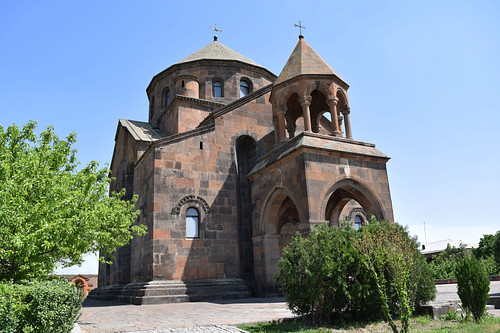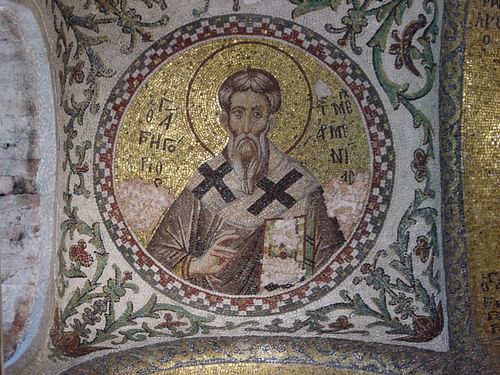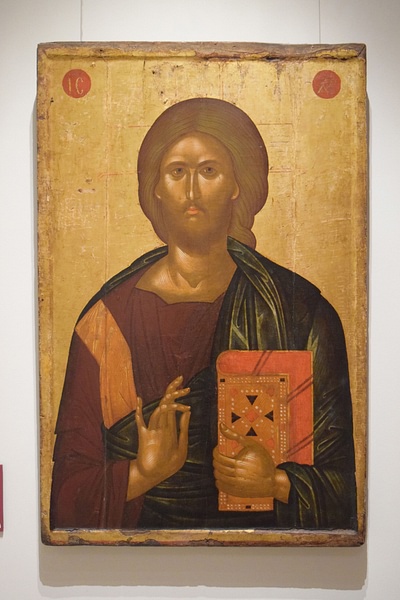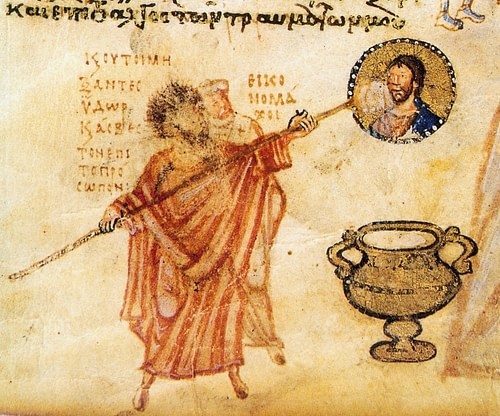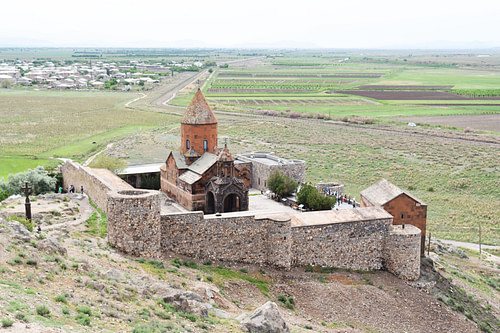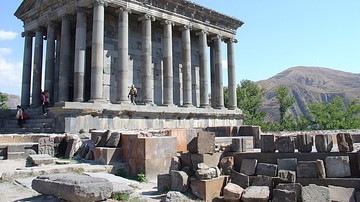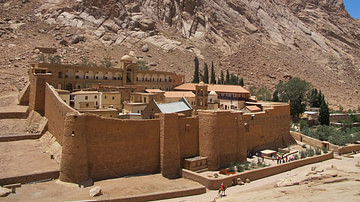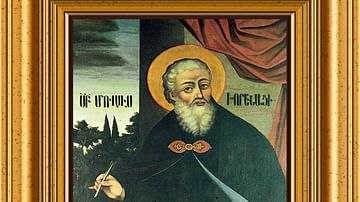Although both the Byzantines and the Armenians were Christian, the types of Christianity they professed had important differences that led to a lack of recognition and tensions between the two groups and a considerable part of their relationship, both internally and in foreign relations, was tied to religion. These tensions and the lack of compromise were an essential part to Byzantine-Armenian relations for centuries and resulted in a lasting separation between the Orthodox and Armenian Churches.
Differences in Beliefs
As with many Christian denominations, there are actually only a few critical differences. The main beliefs, such as Jesus being the Son of God, life everlasting, and communion, were for the most part the same. The major disagreements between the Armenian and Orthodox Churches can, for the sake of medieval theology, be broken down to two major points of contention. First, the Armenians rejected the Fourth Ecumenical Council, which was recognized by the Patriarch of Constantinople and the Pope in Rome, although many in Syria and Egypt opposed it. Second, the Armenian Church maintained that it was an autonomous church, which ran counter to Byzantine opinions on the matter. Although there were other issues, such as the Armenian use of unleavened bread and unmixed wine for the sacrament, these two matters were the main two points of contention.
The Fourth Ecumenical Council, held at Chalcedon, occurred in 451 CE. No Armenian delegates were present at the Council, due to a national disaster at the Battle of Avarayr, just a few weeks before, where many leading Armenians had been slain by the Sassanid Persian army. The Council of Chalcedon stipulated the nature of Christ, a question that had led to religious divisions and disputes well before even the First Ecumenical Council at Nicaea in 325 CE. The Fourth Ecumenical Council decided that Christ had two distinct natures, one human and one divine, perfectly united in hypostasis with neither being superior or inferior. Naturally, any standpoint that was different than this was deemed heretical. The decision received much resentment in the eastern provinces of the Byzantine Empire, where many locals believed in the Christological position of Monophysitism.
Monophysites believe that Christ has one nature, where divinity and humanity are perfectly united. Among these dissenting people were the Armenians. The lack of Armenian participation did not incline the Armenians to agree to the Council's decisions either, as their voices and concerns had not been heard. In addition, the presiding emperor, Marcian (r. 450-457 CE), rejected Armenian requests for aid against the Persians. Two of Marcian's successors, Zeno (r. 474-491 CE) and Anastasius I (r. 491-518 CE), even disavowed the Council of Chalcedon, further hurting its reputation, although it was reaffirmed under Justin I (r. 518-527 CE). The Armenians recognized the Third Ecumenical Council, at Ephesus in 431 CE, as the last legitimate one, not recognizing the Council of Chalcedon or any succeeding councils that are considered ecumenical in the Orthodox tradition. This standpoint had been originally stated at the First Council of Dvin in 506 CE, and later reaffirmed in 554 CE.
The second major issue was the autonomy of the Armenian Church. Armenia was the first Christian nation in the world, St. Gregory the Illuminator having converted King Tiridates (Trdat) the Great (r. 287-330 CE) in the early fourth century. St. Gregory himself was the bone of contention. Leontios, Archbishop of Caesarea, had consecrated St. Gregory, and the Byzantines believed that this made him and those that he converted beholden to the diocese of the Archbishop of Caesarea. The Armenians argued that although St. Gregory had converted their king, the tradition of Armenian Christianity was actually much older, having been started by the conversions of the Apostles Thaddeus and Bartholomew back in the few decades after the death of Christ. This apostolic origin, in their eyes, gave them an inviolable right to an autonomous church, since their church had in fact been created around the same time that the first Christian missionaries ventured outside of Palestine.
Another point, made by the 7th-century Armenian historian Sebeos, is that Jesus taught the apostles; therefore, it was perfectly fine that St. Gregory was taught in Caesarea, as education is an essential part of Christianity, not a subservient one (Sebeos 114-132). For the Armenians, preserving the autonomy of their national church was also tied to the preservation of their political autonomy and ethnic identification. To the Byzantines, it was important to have the Armenian Church recognize the superiority of the Archbishopric of Caesarea so that it would technically be under the dominion and influence of the Byzantine Empire. When the Armenians were under Persian or Arab control, they were allowed greater leeway in their ecclesiastical administration, and, of course, the Armenian Church was given full support by the independent Armenian states of the 9th, 10h, and early 11th centuries. Although this had always been a contentious subject between the Byzantines and Armenians, it was especially strained during the periods of Byzantine rule over Armenia, in the 7th and 11th centuries. This was where religious tensions bubbled to the surface and impacted the failures of Byzantium during those centuries.
Monothelitism
In exchange for helping him retake the Sassanid throne, Khosrow II (r. 590, 591-628 CE) had ceded most of Armenia to Emperor Maurice (r. 582-602 CE). It was under the Heraclian Dynasty (r. 610-695, 705-711 CE), however, that the Byzantines became most directly involved in Armenian religion for the first time. Heraclius (r. 610-641 CE) had discussed ecclesiastical union with Armenian clergymen when he was in Armenia during his campaigns against the Persians, and once the Byzantine reconquest of the region was complete, he opened up more extensive negotiations. In 632 CE, Heraclius went to Theodosiopolis and reached an agreement with the Armenian Catholicos Ezr at the Council of Karin that resolved some minor differences between the Armenian and Orthodox Churches, removing the additional Armenian part of the Trisagion, one of the hymns of the Divine Liturgy, and moving the Armenian celebration of Christmas back to the Orthodox date of 25 December. In 632 CE, the Greeks and Armenians celebrated Christmas mass together because of this change.
Heraclius also settled on a compromise formula, which became known as Monothelitism, that he hoped would appease the Armenians while not directly ignoring the rulings of the Council of Chalcedon. Monothelitism was a Christological doctrine that taught that Christ had two natures, like the Council of Chalcedon's position, but had one will, similar to the singular nature proposed by the Monophysites. It was created to settle the question once and for all so that all Byzantine subjects could cooperate and strengthen the Byzantine defenses against the new enemy starting to emerge from the sands of Arabia.
Many Armenian monks and bishops in the east did not accept the actions of Ezr, and some no longer honored him as catholicos, harshly criticizing his decision. The Armenian Council of Dvin officially renounced Ezr's agreement with Heraclius in 645 CE, again only recognizing the first three ecumenical councils. The agreement was most likely only agreed upon in the first place because of Armenian fear of Byzantine repercussions or because Ezr was convinced by Heraclius' compromise agreement, either by conviction or bribe. Once the Arabs had invaded the country, they greatly supported the concept of an Armenian Church, as it created a rift between the Byzantines and Armenians.
Monothelitism was resented by most of the Armenians, now the only real Monophysite population left under Byzantine rule after the fall of Syria and Egypt to the Muslims. Monothelitism was also disliked by the Orthodox Byzantines as a dilution of the true creed of the Church. The ethnic and religious animosities between Greeks and Armenians were only inflamed by Monothelitism, which created division between the royal house and both its Byzantine and Armenian subjects, inhibiting a strong defense of the Byzantine Empire, especially in Armenia. The issue lingered during the reign of Constans II (r. 641-668), despite Constans issuing a Type, which tried to shove the issue under the rug by banning everyone in the empire from even discussing the matter of Monothelitism. A weak understanding between the churches was again achieved when Constans entered Dvin with the Byzantine army in 652 CE, forcing a union of the churches. Monothelitism was finally turned over by the Sixth Ecumenical Council in 681 CE, which reaffirmed the Council of Chalcedon's verdict on Christ's nature. It was briefly resurrected under Emperor Philippikos Bardanes (r. 711-713 CE) in 711 CE, but was heavily resented by nearly everyone and did not survive Bardanes' downfall two years later.
Later Reunification Talks
Although it had been an utter failure, Monothelitism was an attempt at compromise between the Orthodox and Armenian Churches. Few attempts at compromise were made after the Sixth Ecumenical Council in 681 CE. In 730 CE, Germanos, the Patriarch of Constantinople, tried to approach the Armenians, but these talks disintegrated due to the rise of iconoclasm. Iconoclasm, the best known of the many Byzantine religious conflicts, was over the question of whether icons could be used as intermediaries in Christianity or whether they constituted a type of idolatry. Lasting from 726 to 843 CE, iconoclasm attracted all of the attention of church officials, putting any sort of talks with Armenia on the sidelines for over a century.
These talks would begin again in earnest under the aegis of Patriarch Photios in the 9th century. Photios, an ethnic Armenian, sent letters to the Armenian Catholicos Zacharias and to the then Armenian prince Ashot I (r. 884-890 CE) hoping to resume talks on church unification. In one letter to Ashot I, Photios purposefully adjusts historical accuracy to placate the Armenians and hopefully create an atmosphere of compromise and openness in doctrinal discussions between the Byzantines and Armenians. The supposed discovery of the relics of three of the most celebrated saints in the Armenian Church, St. Gregory the Illuminator, St. Hripsime, and St. Gayane, was also a gesture of reconciliation and recognition towards the traditions of the Armenians. The Armenians already had the relics of these saints in Armenia, and they had been venerated for years, so the announcement was ignored. The action, however, was important for showing a gesture of conciliation and respect to the Armenians, something that had mostly been lacking in previous talks on church union.
The Council of Ŝirakawan came together to discuss Christological issues in 862 CE, where John, the Metropolitan of Nicaea, met with Catholicos Zakaria, many leading Armenian clergymen, and even the commander-in-chief of Armenia, Ashot Bagratid, later Ashot I. Although the talks ultimately came to nothing, as the Armenians and Byzantines simply agreed to disagree, it was a real effort towards interchurch dialogue, directed by the honest intentions of Photios, as well as the interests of Ashot I and Zakaria in increasing Armenian influence in the Caucasus, and not overshadowed by Byzantine threats or saber-rattling. Any chance of reopening talks during Photios' second stint as Patriarch was dashed by the death of Catholicos Zakaria and a lack of more conciliatory counterparts in Armenia with which to open talks. In the end, there was a modus vivendi between the two peoples, coexisting peacefully and quite amicably for nearly a century before tensions began to bubble up again.
Failure to Compromise
The period after Emperor Basil II's (r. 976-1025 CE) death, between 1025 and 1071 CE, became the most oppressive period for Armenians in Byzantine history. With the conquests of the Armenian states before and during this period, the Greek clergy started to insist on Armenian conversions to Orthodoxy. Without an ethnically Armenian state to defend them, the Armenians were left to handle their tenuous situation in the Byzantine Empire on their own. Emperor Constantine IX (r. 1042-1055 CE) kept two Armenian Catholikoi, Petros and Khatchik II, in Constantinople as virtual prisoners. Constantine IX also tried to have the position of Armenian Catholicos abolished entirely and had Byzantine soldiers torture Armenians in Sebastia to uncover the whereabouts of church wealth. All of these actions led to the deep Armenian resentment against the Byzantines.
The situation for the Armenians became so bad that Syrian Patriarch Michael the Great, in the following century, said that the evil influence of Satan must have caused the Byzantines to do such terrible things and the Patriarch of Constantinople to order the trampling underfoot of Armenian liturgical texts and holy oil (Michael the Great, 175). Although there was widespread state-directed persecution, there is no mention in any primary source of an attempted mass conversion of all Armenians, especially not the large Armenian contingent in army or the ethnically Armenian Byzantine aristocracy.
The elimination of the Armenian Church theoretically would serve Byzantium well. It would remove a source of Armenian national identity and affirm religious orthodoxy throughout Byzantium. Although political considerations were, of course, important, it is important to remember how important religious beliefs were in the Middle Ages, and that the Byzantines had no small interest in bringing the Armenians into the Orthodox fold. It is true that any chance of discussion would almost immediately break down on the intransigence of religious beliefs, but this obstinacy was not just on the part of the Byzantines. Neither the Byzantines nor the Armenians gave much credence to the religious arguments of the other, and neither one would really budge on their own stance, preventing any sort of compromise agreement.
Armenians, like every people, had multiple aspects, and this was certainly true for religion. The Armenians were guilty of religious prejudice just like the Byzantines. The Armenian historian Matthew of Edessa ridiculed Greek religious practices, such as their date for Easter, and blames the mistakes of the Orthodox Church for a multitude of political and natural disasters (Matthew of Edessa, 41-42). Byzantine soldiers under Constans II complained of disrespect by the local Armenians and the anathemas against them by the Armenian clergy. At other points, however, they could be surprisingly amenable, such as when Catholicos Nerses III invited Constans to see the newly completed Church of St. Gregory.
Above all, the Armenians steadfastly and stubbornly defended the autonomy of their church. Catholicos Khatchik I defended those Armenians that lived in the Byzantine Empire against the encroachment of Greek clergy at the end of the 10th century. In fact, the Armenian Catholicoi were generally known for being tough on matters of religion, Khatchik II maintaining his Monophysite beliefs even in the face of Byzantine persecution, as did several other Catholikoi that were taken captive by the Byzantines. Armenian historians took a certain pride in describing how fellow Armenians went to Constantinople and refuted all of the questions of leading Orthodox clergymen and emperors. Matthew of Edessa mentions an Armenian vardapet, a highly educated Armenian churchman, visiting Constantinople at the behest of John I Tzimiskes (r. 969-976 CE), perfectly refuting the questions of the church doctors in the Hagia Sophia. Gagik II of Armenia (r. 1042-1045 CE) does a similarly laudatory job when arguing on behalf of the beneficent treatment of Armenians to Constantine X Doukas (r. 1059-1067 CE).
CONCLUSION
The overarching theme between the Armenians and Byzantine Orthodox was religious intolerance on both sides. Of course, there were exceptions. The churches occasionally had more amicable relations, such as the attempt at compromise at the Council of Ŝirakawan in 862 CE, and both churches agreed on the heretical nature of groups such as the Paulicians and Tondrakians. The Armenian historian Ghevond even lauded Leo III (r. 717-741 CE) for defending Christianity in a letter to Caliph Umar, despite the fact that Leo was an Orthodox Christian. This is exemplary of a theme present throughout this period: for the Armenians, Byzantine rule was preferable to domination by a Muslim power. Many Byzantines, when faced with a similar choice of rule by a different Christian sect or Muslims, expressed the sentiment supposedly stated by the Megas Doux Loukas Notaras, that it was better to see the turban of the Turk ruling in the City than the Latin mitre. Not so for the Armenians. Despite the generally religiously intolerant atmosphere of medieval Byzantium, where heresy was indistinct from treason, most Armenians readily supported the Byzantines over the Muslims. Some Armenians even converted by choice after immigrating to Byzantium, many times to achieve a better position in society.
The tensions and conflicts that stemmed from the differences between the Byzantine Orthodox Church and the Armenian Church were nonetheless vital factors in Byzantine-Armenian relations. This difference helped to preserve Armenian culture over the centuries, but also inhibited a closer relationship between the two peoples. In the end, religious differences would greatly contribute to the final breakdown of Byzantine-Armenian relations and help guide the split between churches that has existed up to today.
